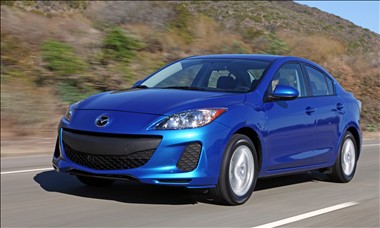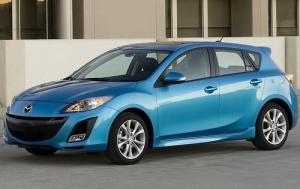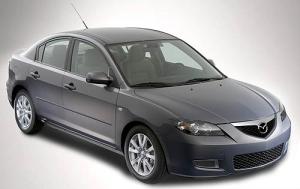In today's very high-priced used car market, it may be the right time to look at "older" models that have aged well as a way to save significant dollars. And the Mazda3 is one of those models and can definitely be a viable and more economical option at this time, with careful shopping.

History has proven that an older but well-maintained Mazda3 can last in the 200,000 - 300,000 mile range, with the key being "well-maintained". This makes careful and possibly patient shopping all the more essential.
And all cars likely have some reported mechanical issues, including some that may be more specific to a particular model, even those with strong reliability reputations. That's just a natural part of car ownership.
So here, ...
- We'll do an overview of some earlier Mazda3 generations, specifically the first and second covering the 2004 - 2013 model years.
- Then we'll list possible mechanical issues for each generation that have been reported by some owners so they can be checked before buying one today.
- And then we'll summarize the overall pros and cons of an older Mazda3 worth consideration for potential buyers today.
Second Generation Mazda3 (2010 - 2013)
While this version had similar underpinnings to its predecessor below, changes were made to improve its power, ride quality and interior refinement. The "s" trims were now powered by a 2.5-liter inline-4 that produces 167 horsepower and 168 lb-ft of torque. It's paired with either a 6-speed manual transmission or the optional 5-speed automatic.
In addition, 2012 3i Touring and Grand Touring models got the more efficient Skyactiv-G 2.0-liter four-cylinder engine (155 hp and 148 lb-ft).
This version came in six trims: i SV, i Sport, i Touring, s Touring, i Grand Touring and s Grand Touring, while the hatchback came only in the four higher trims. Features found in models can range from items such as 1-touch power windows, a height-adjustable driver seat, 4-wheel ABS and steering-wheel-mounted audio controls in the SV to leather upholstery, heated front seats and navigation in the top-of-the-line Grand Touring.
In addition, the previous generation's "attractive" interior was upgraded to one of the best in its class with high-grade materials and plenty of features, while the hatchback offers particularly generous storage room as well. Both body styles also come with a convenient 60/40 split-folding rear seat for added cargo capacity when needed.

Like its predecessor, this Mazda3 offered a level of refined road manners that belie its "economy car" status ... and even moreso. Blessed with a performance-oriented chassis tuning as well as quick and fairly responsive steering, this Mazda3 is a capable and confident handler.
Even so, its highway ride is likely still smooth enough to satisfy most, although perhaps some used to softer suspensions may find it on the firm side.
Here's a summary of the more significant changes over these years to bear in mind:
Year-To-Year Changes:
2010 Mazda3: Under went a major redesign including a revised styling, additional power, better fuel economy, an upgraded cabin and new upscale features.
2011 Mazda3: Stability control became standard on all models, while the Grand Touring model was given a standard sunroof and Bose audio system, but lost its standard adaptive xenon headlights.
2012 Mazda3: The new Skyactiv-G powertrain became available and improves both power and gas mileage compared to the standard 2.0-liter version. In addition, some new trim levels were added, there were some minor changes to the interior and exterior designs, as well as some additional standard features.
2010 - 2013 Mazda3 Possible Mechanical Problems
While the second generation Mazda3 generally proved to be a quite reliable vehicle, like all vehicles, it wasn't without some reported issues. Here are some common mechanical problems or issues reported by owners that should therefore be included in a pre-purchase inspection:
Car Buying Tips:
Do This For The Best Trade-In Price
Rust Issues: Some owners reported issues with rust forming on certain parts of the vehicle, particularly in regions with harsh winter climates or exposure to road salt. This is a common concern for cars of this era.
Power Steering Pump Noise: Some drivers experienced noise issues with the power steering pump, including whining or grinding sounds.
Transmission Issues: While not widespread, there were occasional reports of transmission-related problems, such as rough shifting or hesitation.
Engine Mounts: There were a few reports of engine mount problems, leading to excessive vibrations or noises.
Suspension Components: Some owners reported issues with suspension components, such as struts and control arms. This could result in a rough ride or handling problems.
Electrical Issues: A few drivers reported electrical problems, including issues with the power windows, door locks, or the infotainment system. These could be related to wiring or component failures.
Water Pump Failures: In some instances, water pump failures were reported, leading to coolant leaks and potential engine overheating.
It's important to emphasize that not all vehicles experienced these issues, and many second generation Mazda3 owners have had positive and trouble-free experiences with their cars.
First Generation Mazda3 (2004 - 2009)

Available as either a sedan or a four-door hatchback, the "i" trims came with a 148-horsepower 2.0-liter four-cylinder engine. The "s" trims had a 156-horsepower 2.3-liter four-cylinder. A 4-speed automatic transmission was optional with the 2.3-liter engine for 2004 and 2005.
Beginning in 2006, the transmission was replaced with a 5-speed automatic. Also in 2006, Mazda3s sold in California-emissions states were partial-zero-emissions-vehicle certified.
Among its most notable features were its easy steering and precise handling, athletic engine (particularly the 2.3-liter), stylish design, front seat space and affordable price. The best description of this vehicle I've heard is, "value-based performance".
By 2007, the sedan was offered in five available models: i, i Touring, s, s Touring and s Grand Touring, while the hatchback was offered in three: s, s Touring and s Grand Touring trims.
During this production run, typical standard features for the base i sedan included 15-inch wheels, a tilt/telescoping steering wheel, a 60/40-split-folding rear seat with a center armrest, an engine immobilizer, 4-wheel disc brakes and a 4-speaker audio system with a CD player and an audio input jack.
The popular i Touring model added such features as full power accessories, 16-inch alloy wheels, keyless entry, air-conditioning, steering-wheel-mounted audio controls, an upgraded audio system, cruise control and a height-adjustable driver seat.
The s models came with all of the above, plus a more powerful engine, unique interior trim accents and a leather-wrapped steering wheel with audio controls.
The s Touring also featured 17-inch alloy wheels and body side sills, while the upscale s Grand Touring model came with automatic climate control, leather upholstery, heated front seats, a trip computer and rain-sensing wipers.
Older models can also be found with options such as navigation (only in the Grand Touring), a sunroof, an in-dash CD changer and satellite radio.
Year-To-Year Changes:
2005 Mazda3: A new sp23 model was introduced and included leather seats and 17 inch alloy wheels.
2006 Mazda3: The short-lived sp23 model was dropped. Instead, the s Touring and s Grand Touring models were added. The features of the s Touring included front side airbags, curtain side airbags and 17 inch wheels.
The s Grand Touring added to the S Touring a leather interior, heated front seats, automatic climate control, trip computer, and xenon headlamps. And all s models were given standard antilock brakes (ABS).
2007 Mazda3: Added a performance model, traction/antiskid control, and some minor cosmetic changes. The MazdaSpeed hatchback was introduced featuring a sport-tuned suspension, xenon headlights, leather upholstery, larger brakes, and 18 inch wheels.
2008 Mazda3: Largely unchanged for the 2008 model year, however, front-seat side airbags and full-length side curtain airbags became standard on all s trim levels.
2009 Mazda3: Antilock brakes (ABS), front-seat side airbags and full-length side curtain airbags are all now standard safety features across the entire model lineup. And the four-door sedan models were given a standard remote trunk release on the keyless entry fob.
2004 - 2009 Mazda3 Possible Mechanical Problems
The first generation Mazda3 generally received positive reviews for its design and driving dynamics. However, like any vehicle, some owners did report mechanical issues which should therefore be checked before buying one today.
Rust Issues: Similar to the second generation, some owners reported rust problems, particularly in regions with harsh winter climates or exposure to road salt. Common areas for rust included the rear wheel arches and suspension components.
Power Steering Issues: A few owners reported issues with the power steering system, including noises (whining or grinding) and occasional stiffness. This could be related to problems with the power steering pump or other components.
Engine Mounts: Some drivers experienced problems with engine mounts, leading to increased vibrations or noise.
Suspension Components: There were occasional reports of issues with suspension components, such as struts and control arms. This could result in a rough ride or handling problems.
Transmission Issues: While not extremely common, a few owners reported transmission-related problems, such as rough shifting or slipping.
Cooling System Problems: Some drivers reported issues with the cooling system, including water pump failures and radiator problems.
Electrical Problems: A small number of owners reported electrical issues, including problems with power windows, door locks, or the lighting system.
Brake System Concerns: There were occasional reports of brake-related issues, such as premature wear or brake noise.
It's again important to note that many first generation Mazda3 owners have had positive experiences without encountering major issues.
Overall Pros And Cons Of An Older Mazda3
Older Mazda3 Pros
Affordability: Obviously, older Mazda3s from the first and second generations are generally more affordable than newer cars, allowing for upfront savings. However, this has to be weighed against the risk of possibly higher repair costs.
Depreciation: Since these cars have already gone through the steepest part of their depreciation curve, they will likely experience slower depreciation going forward.
Reliability: Both generations have a reputation for reliability, and well-maintained, lower-mileage models may provide a dependable and long-lasting driving experience.
Fuel Efficiency: Mazda3s, especially with smaller engines, tend to be fuel-efficient, helping save money on fuel costs.
Styling: The Mazda3 is known for its sporty and attractive design, offering a stylish look that remains appealing even in older models.
Agile Handling: It offers responsive and agile handling, providing an enjoyable driving experience.
Comfortable Interior: The cabin is generally well-designed with comfortable seats and user-friendly controls.
Safety Features: Depending on the trim level, it may come equipped with safety features such as stability control, antilock brakes, and side airbags.
Affordable Maintenance: The cost of maintenance and repairs is often reasonable compared to some competitors.
Older Mazda3 Cons
Potential Mechanical Issues: Older cars, regardless of brand, may be more prone to mechanical issues or wear and tear. It's crucial to carefully inspect the specific used car and check its maintenance history.
Technology: Older models may lack some of the advanced technology features found in newer cars. This includes infotainment systems, advanced safety features, and connectivity options.
Limited Space: Both generations may have limited rear seat space, which could be a concern if you regularly carry passengers.
Outdated Styling: While the Mazda3 has a timeless design, some buyers may prefer the updated styling of newer models.
Road Noise: Some owners have reported that road noise can be more pronounced compared to some competitors.
Ride Comfort: While the handling is praised, the ride might be a bit firm for some, especially on rough roads.
Limited Standard Features: Base models might lack some of the advanced features that come standard on newer vehicles.